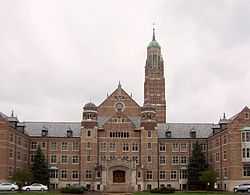Pontifical College Josephinum
| Pontifical College Josephinum | |
|---|---|
 | |
| Motto | Forming Holy, Competent Priests for the Real World; Good Shepherds and Spiritual Guides for the New Evangelization. |
| Established | 1888 |
| Type | Private |
| Religious affiliation | Catholic Church |
| Chancellor | Most Rev. Carlo Maria Viganò, Apostolic Nuncio to the United States |
| Rector | Very Rev. Msgr. Christopher J. Schreck |
| Academic staff | 38 |
| Location | Columbus, Ohio, United States |
| Campus | Suburban 100 acres (0.4 km2) |
| Affiliations | North Central Association of Colleges and Schools (since 1977) and Association of Theological Schools in the United States and Canada (since 1970) |
| Website | pcj.edu |
The Josephinum was granted pontifical status in 1892 by Pope Leo XIII, recognizing her unique mission of forming priests for the international Church. The seminary's vision, as set forth by its Rector and Board of Trustees, is: "Forming Renaissance Priests: Spiritual Fathers for the New Evangelization."
History
Overview

Background
In the early 1870s, inspired by the orphanage work of Father Jessing, when four older boys indicated a desire to serve the Church as Roman Catholic priests, Father Jessing advertised in his German-language newspaper that he would be willing to sponsor two boys who wished to become priests but who lacked the financial means to do so. Jessing accepted twenty-three of the more than forty applicants who replied. Originally his new seminary was called the Collegium Josephinum and was located in downtown Columbus.
As those first students progressed through the seminary program, the institution initially provided six years of primary education ("minor seminary," four years of high school and two years of college/pre-theology) and six years of secondary seminary education ("major seminary," another two years of college/pre-theology and four years of theology/ seminary). Father Jessing lived to see the first class of six seminarians ordained to the priesthood in June 1899 but he died less than six months later.
Pontifical status

Relocation to present campus
In 1931, the Josephinum moved to its present location just north of Worthington, Ohio and eleven miles (18 km) north of downtown Columbus on a landmark 100-acre (0.40 km2) campus. (The current size of the campus is slightly less than 97.5 acres (395,000 m2) with another approximately 12-acre (49,000 m2) parcel close by.)
The academic structure of the seminary changed over time during the 1940s and 1950s from the "six-six" format to four years of high school, four years of college, and four years of theology/seminary (though the distinctions were gradual and unclear). Reflecting the German origins of its founder and its service to the German-speaking community, the seminary high school and college held almost all classes in German until the influx of non-German speaking students made this no longer practical. One can only begin imagine the difficulty for a new non-German speaking student to take Greek and Latin classes in German. The first official College commencement occurred in June 1953; the College and Recreation buildings were dedicated in 1958; and the high school closed in 1967.
For the first few decades of its existence, the seminary focused its work on educating priests to work with the large population of German immigrants in the United States. The Josephinum was incorporated under the laws of the State of Ohio in 1894; its Constitution was first approved by Pope Pius XI in 1938 and was most recently revised and approved by the Congregation for Catholic Education in 1996.
Modernization and increasing international focus
In the years after World War I, the focus of the seminary shifted away from its original mission of meeting the spiritual needs of German-speaking Catholics to a wider mission of preparing priests for dioceses throughout the United States that lacked their own seminary. With the advent of the Second Vatican Council in 1962, the Church took on a more outward-looking and evangelical orientation. It was only natural that seminaries like The Josephinum also become increasingly involved in outreach and ministry work in the their local communities. This trend continues today.
Today, The Josephinum is under the direction of Msgr. Christopher J. Schreck, a priest of the Diocese of Savannah. Josephinum alumni serve the Church in 48 states and 22 foreign countries. The Josephinum continues to prepare priests for U.S. dioceses that do not have their own seminaries, missionary areas of the United States, including regions of the U.S. with growing Hispanic communities and finally, dioceses around the world in need of help with the education of their seminarians.
Accreditation and certifications
Led by a decades long effort by its most significant graduate and 20th Century leader, Msgr. Leonard J. Fick, the Josephinum was accredited by The Higher Learning Commission, an affiliate of the North Central Association of Colleges and Secondary Schools in 1976. The Josephinum has been accredited by the Association of Theological Schools in the United States and Canada since 1970. The seminary also holds a Certificate of Authorization from the Ohio Board of Regents.
See also
External links
Coordinates: 40°07′12″N 83°01′05″W / 40.120037°N 83.018183°W